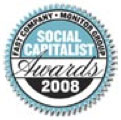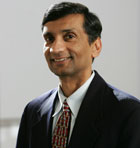 |
|
 "The Inner Circle" THE PROBLEM: In 2003, PSI was well-known within its segment of the global health world and by a small group of longstanding donors. But in a dinner I had in Boston that year, a friend of mine - a former PSI country representative who now worked as an advisor in the social philanthropy world - told me that PSI was not known at all among a group of influencers that we dubbed "The Inner Circle." These were academics like Jeffrey Sachs and C.K. Prahalad, publications like Fast Company and centers of social innovation like Stanford University. These were not people or institutions likely to fund PSI, but who influenced those who might. I started to think about how to tackle this somewhat amorphous challenge of educating people who were outside of our world, but might influence it. THE SOLUTION: In consultation with colleagues who knew the social philanthropy world, I developed a list of influencers thought to be members of the "The Inner Circle" and began strategizing on how to engage them. I immediately reached out to Harvard Business School, which had developed a case study on PSI's family planning program in Bangladesh 20 years ago that was still being taught at Harvard and other business schools. I proposed a new PSI case study based on a different kind of PSI project. Professor Kash Rangan, who had written that case study, responded very enthusiastically and we began to keep in touch and exchange ideas. I led an effort to submit a proposal for PSI to be one of the "Social Capitalists" of the year, an annual competition run by Fast Company and the Monitor Group. THE RESULTS: In 2006, PSI won a "Social Capitalist" award on it first attempt. In 2007, it won again, and this time we were featured prominently on the first two pages with a huge photo from our Kenya safe water program. In March 2005, I spoke on creative and inexpensive ways to market a social cause at a Harvard Business School conference and was quoted in Harvard Business School Working Knowledge website. At the end of that panel discussion, I met with Professor Rangan to brainstorm on ideas for a future case study. In 2006, after much effort, Harvard Business School came out with its first case study on a PSI project in 21 years, an examination of a PSI HIV prevention campaign in India. And in 2007, another Harvard Case Study on the social marketing of safe water. And here is the case study itself. PSI has continued to be featured in the case studies of prominent universities and in the pages of magazines like Fast Company and Stanford Social Innovation Quarterly but it all started in our concerted effort to break into "The Inner Circle." And I am convinced that these efforts have had an impact on PSI's image with a new audience and, ultimately, with the bottom line. Fast Company - Social Capitalist Awards (PDF) Safe Water - HBS Case Study (PDF) |
|
 Kash Rangan, courtesy of the Harvard Business School website. The Story that Helped Put PSI on the Map Once Iconoclastic, Harvard Case Study Has Gone Mainstream CAMBRIDGE, Massachusetts - In the fall of 1983, V. Kasturi Rangan, a young and ambitious marketing professor, arrived at Harvard Business School to start his new job, full of dreams and hoping to leave his mark on the nation's top business school. He did that, but in the process, ran up against the Harvard establishment and also helped pull an equally young and ambitious non-profit organization called PSI out of obscurity. Twenty years later, both Professor Rangan and PSI are surviving, even thriving. Professor Rangan, more popularly known as Kash, is the author and creative force behind a fabled piece of PSI history - the HBS case study on PSI's contraceptive social marketing project in Bangladesh. First published in 1985 over the strenuous objections of the HBS powers-that-be, the case study is still being taught to thousands of first-year business students at Harvard and other business schools in the U.S. and around the world. But, for a while, it looked as though the case study would never see the light of day. Kash first read of PSI and our Bangladesh project in an article in Marketing News in 1983, nine years after it had started. At the time, PSI was a small, unknown non-profit organization of no particular consequence, operating on the fringes of the global health world, based in New York. It was headed by Executive Director Bob Ciszewski, who had also served as PSI's first country representative in Bangladesh, which was still its only project at that time. When PSI won its first two-year contract from USAID/Bangladesh in 1974, PSI and social marketing were so unknown and untested that USAID would only give cash advances to the project one month at a time. By 1983, PSI was starting to make an impact on family planning in Bangladesh, and attract some attention. Kash saw the potential for an intriguing case study unlike any that HBS had done before. He made the first visit with a senior colleague to PSI's offices in New York, but the meeting did not go well. Unlike other HBS case meetings, the host was unprepared to brief the team with the kind of detail they would have liked. So his superiors, while not derailing his initiative, did not share Kash's enthusiasm. His HBS mentor and others told him that it "was not a Harvard Business School case study" and questioned why he would waste his time and political capital on such a misguided effort. He persisted, and proposed a trip to Bangladesh to visit the project and interview the principals. He was turned down for funding. Since Kash is of Indian origin, he decided to make the Bangladesh visit a personal one, with India added to the itinerary. Kash returned to Cambridge and wrote up the case study. But only two of the nine first-year marketing professors would agree to teach the Bangladesh case study. It simply was considered too controversial by Harvard Business School standards. Eventually, Kash, a senior colleague and a visiting faculty member taught the case. The rest of the professors came on board the next year, Kash says, "because the case was conceptually refreshing, and worked like a charm." Twenty years later, HBS is still teaching the Bangladesh case study to first year marketing students; the iconoclastic has gone mainstream. Not only is Kash Rangan still gainfully employed by Harvard Business School, he went on to become head of the core first-year marketing course (1993-1996) and chairman of the Marketing Department (1998-2002). Eventually, he received the ultimate vindication for his youthful follies. When John Whitehead, an ardent supporter of the school, provided the seed money for HBS's Social Enterprise Initiative, HBS Dean John McArthur asked Kash to co-chair the new initiative, partly because of the audacious Bangladesh case study. Kash continues as co-chairman of the Social Enterprise Initiative, which provides resources to send a new generation of young and ambitious HBS professors around the world to such unHarvard-like places as the Philippines, Kenya and Zambia to test and document experiences and insights gleaned from development projects. So the Bangladesh social marketing project, conceived by the pioneers of PSI and successfully implemented by several succeeding generations of PSI social marketers, has contributed to the education of thousands of top business students. It has also helped bring needed attention to PSI and social marketing, which have, in turn, greatly increased the amount of health impact we have produced since that time. - David J. Olson |
